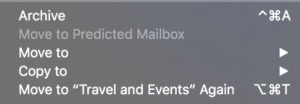If I was to summarize 2017 it would be: AI, HDR, VR, AR and Resolve. If you missed any trend they would be Artificial Intelligence (really Machine Learning); High Dynamic Range; Virtual Reality (i.e. 360 or 180 degree video); Augmented Reality; and Blackmagic Design’s Resolve 14.
As Augmented Reality is composited in at the viewer’s device, I doubt there will be any direct affect on production and post production.
Virtual Reality has had a good year with direct support appearing in Premiere Pro CC and Final Cut Pro X. In both cases the NLE’s parent purchased third party technology and integrated it. Combined with the ready availability of 360 cameras, there’s no barrier to VR production.
Except the lack of demand. I expect VR will become a valuable tool for a range of projects like installations, telepresence and travel, and particularly in gaming, although that’s outside my purview.
What I don’t expect is a large scale uptake for narrative or general entertainment functions. Nor in most of the vast range of video production. It’s not a fad, like 3D, but will likely remain a niche in the production world. I should point out it’s very possible to make good money in niches!
Conversely I would not buy a new screen without it being HDR compatible – at least with one or two of the major HDR formats. High Dynamic Range video is as big a step forward as color. I believe it provides a fundamentally better viewing experience than simply upping the pixel count.
High Dynamic Range is supported across the most important editing software but suffers from two challenges: the proliferation of competing standards and studio monitoring.
The industry needs to consolidate to one standard, or sets will have to be programmed for all standards. None currently are. Ultimately this will change because it has to, but some earlier set purchasers will probably be screwed over!
HDR studio monitors remain extremely expensive, and hard to find. There’s also the problem of grading for both regular and high dynamic range screens.
I have no doubt that HDR is fundamental to the future of the “television” screen. It will further erode attendance in movie theaters as the home experience is a better image than the movie theater, and you get to control who arrives in your media room!
In 2017 Resolve fulfilled it’s long growing promise of integrating a fully feature NLE into an excellent grading and DIT tool. One with a decent Digital Audio Workstation also integrated. Blackmagic Design are definitely fulfilling their vision of providing professional tools for lens-to-viewer workflows, while continuing to reduce the cost of entry.
When you hear that editors in major reality TV production companies don’t balk at Resolve, despite being Media Composer traditionalists, I do worry that Avid may be challenged in its core market. Not that any big ProdCo has switched yet, but I wouldn’t be surprised to see significant uptake of Resolve as an editing too in 2018.
My only disappointment with Resolve is that, as of 14.1, there is now way to bridged timed metadata into Resolve. Not only does that mean we cannot provide Lumberjack support, but no transcript (or AI derived metadata) import either. It’s frustrating because version 14 included Smart Collections that could function like Keyword Collections.
In another direct attack on Avid’s core markets, both Resolve and Premiere Pro CC added support for bin locking and shared projects. Implemented slightly differently by each app, they both mimic the way Media Composer collaborates. Resolve adds a nice refinement: in app team messaging.
The technology that will have the greatest affect on the future of production has only just begun to appear. While generally referred to as Artificial Intelligence, what most people mean, and experience, are some variation on Machine Learning. These types of systems can learn (by example or challenge) to expertly do one, or two tasks. They have been applied to a wide range of tasks as I’ve written about previously.
The “low hanging fruit” for AI integration into production apps are Cognitive Services, which are programming interfaces that help interpret the world. Speech-to-Text, Facial recognition, image content recognition, emotion detection, et. al. are going to appear in more and more software.
In 2017 we saw several apps that use these speech-to-text technologies to get transcripts into Premiere Pro CC, Media Composer and Final Cut Pro X. Naturally that’s an area that Greg and I are very interested in: after all we were first to bring transcripts into FCP X (via Lumberjack Lumberyard). What our experience with that taught us is that getting transcripts into an NLE that doesn’t have Script Sync wasn’t a great experience. Useful but not great.
 Which is why we spent the year creating a better solution: Lumberjack Builder. Builder is still a work in progress, but it’s a new NLE. An NLE that edits video by editing text. While Builder is definitely an improvement on purely transcription apps, it won’t be the only application of Cognitive Services.
Which is why we spent the year creating a better solution: Lumberjack Builder. Builder is still a work in progress, but it’s a new NLE. An NLE that edits video by editing text. While Builder is definitely an improvement on purely transcription apps, it won’t be the only application of Cognitive Services.
I expect we at Lumberjack System will have more to show later in the year, once Builder is complete. I also expect this is the year we’ll see visual search integrated into Premiere Pro CC. Imagine being able to search b-roll by having computer vision recognize the content. No keywording or indexing.
Beyond Cognitive Services we will see Machine Learning driving marketing – and even production – decisions. In 2018, the terms Artificial Intelligence, Machine Learning, Deep Learning, Neural Networks will start appearing in the most unexpected places. (While they describe slightly different things, all those terms fall under the Artificial Intelligence umbrella.)
I’m excited about 2018, particularly as we do more with our new intelligent assistants.

